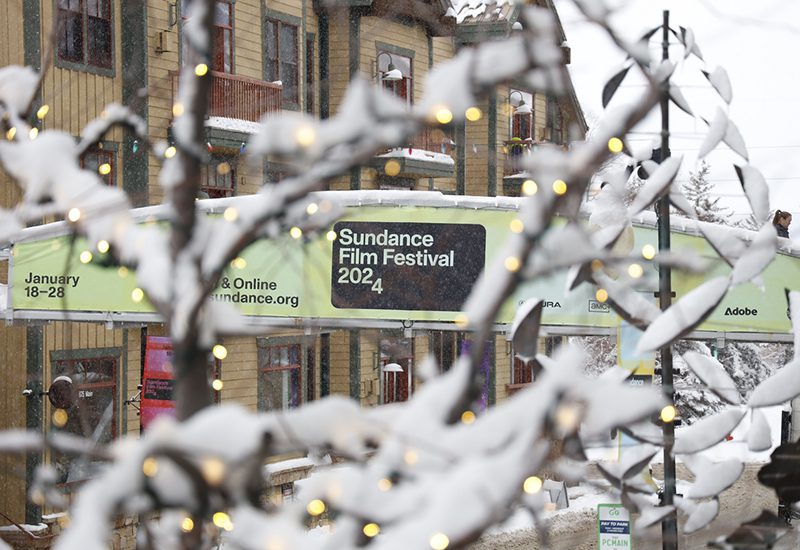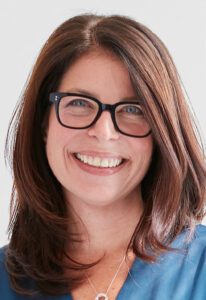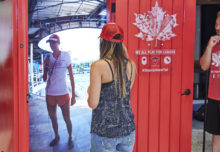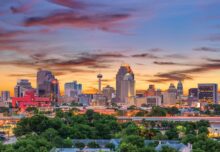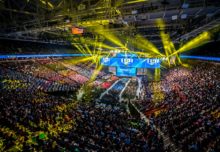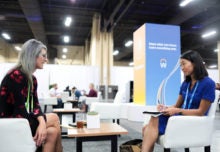For a creative brand like Adobe, Sundance Film Festival is a hot-spot in a cold spot to reach filmmakers and creatives that utilize the brand’s tools daily to deliver works of cinematic art. Over the last 13 years as a lead sponsor, Adobe has leveraged the festival as a platform to merge product announcements with events and CSR missions to help tell a cohesive story about its brand and mission.
This year, Adobe is standing up that sponsorship with its first-ever owned space in Park City, UT, dubbed Adobe on Main, which is open this weekend, Jan. 19-22, and features three days of panel discussions, livestreams of creator interviews and how-to talks from the space in front of a live audience, and other activities and moments of respite for attendees.
Leading the brand’s efforts in Park City is Heather Freeland, chief brand officer at Adobe, who oversees brand strategy, from creative expression to brand partnerships in culture, entertainment and sports to integrated marketing efforts. Ahead of the opening of Sundance Film Festival on Jan. 18, we hopped on a call with Freeland to talk program strategy, engagement and advice for fellow brand marketers making the trek. (Read our recap of other top Sundance 2024 activations here.)
 From the Sundance Archives:
From the Sundance Archives:
- Inside Seven Sundance Sponsorship Activations, from the Acura Village to the Audible Listening Lounge
- Lodges and Lounges: Brands Offer Heated Hideaways, VIP Spaces & Music Events at Sundance Film Festival
Event Marketer: How important is experiential marketing in your playbook as a marketer and also for the Adobe marketing organization?
Heather Freeland: One thing that is both my philosophy and that is an increasing trend in the industry is this move to really finding a balance between advertising and experiences. Particularly for a brand like Adobe, where the notion of community and bringing people together who are using our products is critical to how we tell our stories, we’re thinking these days—through all of our existing partnerships, whether it’s sports or industry or otherwise—about how do we bring our brand to life and make it more tangible? How do we bring our products directly into the hands of people through these events and experiences we’re creating?
Tell us about the decision, after 13 years as a lead sponsor, to host a dedicated brand space for Adobe at Sundance?
Last year’s [festival] was my first year at Sundance. Walking up and down Main Street, I was blown away by how different brands were showing up in different spaces. There were brands there who were doing a lot to build connections with customers with brilliant activations but I wouldn’t necessarily say were a part of the filmmaking process themselves. I walked away thinking that Adobe has a right to be here and should be a centerpiece of what’s happening on Main Street, given how much of what happens at this event comes from our products.
This year, we’ve got an incredible number of films that were produced using our tools—57 percent of the festival’s entries used Premiere Pro, and 83 percent used one of our Creative Cloud applications and products in the creation of them. So, these are our people, this is our community and I think we have the right to have a stronger voice and to use this as a moment to bring them together.
How would you describe Adobe on Main?
We’ve taken over a gallery space and really made it uniquely our own. You’ll see it from the outside of the space, too, how it brings in our brand design elements. But on the interior of the space, we’re bringing it to life through murals and beautiful installations and ways to engage with our product that allow people to kind of touch and feel and interact with it. But back to my point about community and how we see our brand as part of bringing the filmmaking community together, what we’re doing is really using it to also host moments that bring people together. So, we have partnerships with Variety and IndieWire, and we’re using those partnerships to curate content as well as our own in this space.
We’re hosting community events, product demos, filmmakers for different panels. We’re bringing in leading talent from some of the most anticipated films there. We’re hosting an event with Variety around the Golden Globes, and really showcasing breakthrough filmmakers this year, as well. It’s about bringing people together to learn from one another, to showcase their work and just connect, right? One of my observations from last year, too, it’s really cold and sometimes you just need a break from the cold. I went out and invested in a new warmer jacket. So, making the space available to students and filmmakers just to come and coalesce and have a respite from the cold, I think is really powerful in just showing our support for the community in big and small ways, too.
View this post on Instagram
When you’re putting together a content program like this, how far in advance does that process start and what is a best practice that you have leaned on this year for it?
It’s interesting to me from the standpoint of event planning. Sundance is more, I would say, last minute than any event marketer would want. Some of that comes from the fact they don’t announce the selection of the films involved until later in the game. A lot of the programming, and even who’s attending the festival, comes down to the last minute, again, based on who gets placed in the festival. So, it has been evolving literally up until the last week in terms of who we’re able to bring on-site in the programs and panels we have. But we start with a strong hypothesis of what we want to accomplish in the environment, the new products we want to highlight, the messages we want to land, including how we want to highlight diverse filmmakers, as an example.
What we do is we create events around the goals that we’ve set for the activation over the course of the festival. And then we start to slot things in around that. But we’ve also learned to be quite flexible based on the talent that we want to bring to the festival and their moving schedules. While we may have an idea of what we want to do, the logistics always come down at the last minute. That’s what’s nice, though, and another benefit of having our own space, it gives us the flexibility to be able to pivot more easily as well.
The Adobe Film & TV Fund is a new initiative that Adobe and the Adobe Foundation is leading. How is that coming to life at the festival?
One of the observations we’ve had over time and we’ve done research on this as well, is that there is really an inequity in terms of training, career opportunities and funding in the entertainment industry. A lot of these diverse filmmakers are not getting the same opportunities that others may. And so, it was really important for us to make sure we were lifting them up. Adobe’s values are a core part of who our brand is and so in the first year of the fund, we committed to $6 million in grants and contributions to organizations, and product donations, all providing access to our tools and products.
We’re collaborating with a range of different global organizations that are committed to the same goals that we are, which is about empowering underrepresented communities and, really making a significant shift in representation of filmmakers and in film and TV. Some of those partners are, of course, the Sundance Institute, of which we’re a sponsor, but also Latinx House and the NAACP. We’ll also make sure that we’re setting up access to our tools. One of the insights that we have is that a lot of these filmmakers can run out of funding as they’re trying to bring projects across the finish line. It’s one thing that we’re really proud of this year because I think it is that perfect intersection of what our products enable and the role we play in the creative community as well as our values.
Finally, what’s top of mind for you heading into the festival?
Some of the films are just going to be incredible. It’s always about the movies, and I try and sneak them in wherever I can, although it tends to be harder than I would like. But from a brand marketing standpoint, I look to learn, right? I think there’s a lot of other brand leaders there who are looking to learn about storytelling and figure out how to be a part of those conversations with the film and entertainment community. I also love the networking with my peers in the industry to understand how they’re doing, or walking up and down Main Street to understand how other brands are activating in this space.
Sundance is attracting more non-endemic brand attendees in recent years. Your best piece of advice for first-time brand marketer attendees?
I got better gloves this year, for sure. I upped the ante on my parka game. But honestly, aside from staying warm, which is critical, is being really flexible, too, and being open to new opportunities. One of the things I loved last year was having enough flexibility in my schedule to be able to fit in a movie. Because that’s what it’s all about. You can’t go to Sundance without seeing a film come to life. These filmmakers often introduce their films, they have a Q&A afterwards, and that’s when you see it come to life. Even if you’re there for networking or to represent your brand, you can’t forget to experience that. The insights I got from our customers during those Q&As about how they think about the editing process or the storytelling process was magical last year. Just really special.
Featured Photo: Courtesy of Sundance Institute


